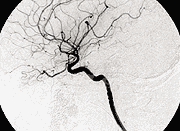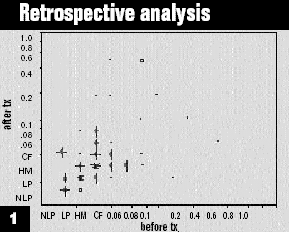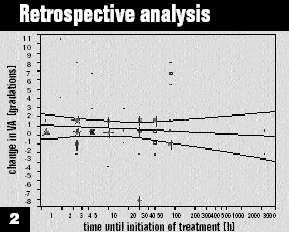Minimally invasive therapies safe but not effective in CRAO
Conventional forms of therapy for retinal artery occlusion will be used as controls in a new controversial treatment trial.
|
|
MONTREUX, Switzerland – Commonly used minimally invasive therapies may only occasionally improve the natural course of clinically complete central retinal artery occlusion, according to a surgeon speaking here.
“These treatments, ranging from ocular massage to administration of aspirin, hyperbaric oxygen, carbogen and others, are relatively harmless but have also no effects on the course of the disease,” said Arthur Müller, MD. Dr. Müller presented his retrospective study and meta-analysis of literature here at the Club Jules Gonin meeting.
A second aim of the study was to create a rationale for a prospective, randomized clinical trial to evaluate another, controversial treatment: selective intra-arterial lysis.
“We need to demonstrate whether selective intra-arterial lysis has a clear beneficial effect on CRAO, and if it can be justified as a treatment in spite of its well-known side effects. We have just initiated this study and we are using minimally invasive therapies for control groups,” Dr. Müller said.
No significant improvement
In the retrospective analysis of the results obtained with minimally invasive treatments, only patients with clinically complete CRAO without a fovea-sparing cilioretinal artery were included. Minimum follow-up was 2 years.
“We identified 65 patients who met these criteria. An astonishing armamentarium of remedies had been used on them,” Dr. Müller said.
According to Dr. Müller, the high number of treatments was due in part to the fact that data from approximately 20 different physicians were analyzed, but also due to physicians urging patients to try multiple treatments.
Average duration of visual impairment until start of treatment was 9 hours. Treatment was started within 24 hours of the onset of symptoms in 62% of patients, and within 12 hours in 55%.
“There was no significant improvement of visual acuity in the overall group using these minimally invasive therapies. Only in 8% of patients did we find an improvement of at least 3 lines of visual acuity. Most of these patients are clustered in the low vision group (below 20/400),” Dr. Müller said.
The time of treatment initiation did not correlate to the change in visual acuity, although there was a trend toward slightly better outcome in cases of earlier intervention (figure 2).
Meta-analysis of results
| ||||||
“For the meta-analysis we only included non-arteritic CRAO studies with a minimum number of 15 patients and comparable inclusion and exclusion criteria. It is notable, however, that most studies included a significant number of patients with a fovea-sparing cilioretinal artery,” Dr. Müller said. (See figures 1 and 2 for the percentage of patients examined in these studies who had an improvement of at least 3 lines of visual acuity).
“On the whole, percentages are low if we take into account that there might be some natural process causing the partial regain of visual acuity in these patients. Two studies reported a relatively large number of patients that were not treated at all, and 10% to 15% of these patients still experienced a significant improvement of visual acuity,” Dr. Müller said.
The studies demonstrated some degree of efficacy in the application of carbogen as a treatment for CRAO, Dr. Müller said. However, as the authors themselves noted in their papers, fluorescein angiography had shown that none of the treated patients had a complete CRAO.
“On the whole, the results found in literature were well comparable with those of our study, and drive us to the conclusion that minimally invasive treatments offer little benefit over the natural course of nonarteritic CRAO. These treatments might be suitable for a control group, however,” he said.
The EAGLE study
As far as the clinical trial on intra-arterial lysis is concerned, the European Assessment Group for Lysis in the Eye (EAGLE) has been established to encompass 18 investigation sites in Germany, Switzerland and Austria.
The study randomizes patients with a clinically complete CRAO to receive either selective intra-arterial lysis or control group that receives minimally invasive treatments.
“In the lysis group, a guiding catheter is inserted through the femoral artery and placed in the internal carotid artery, and heparin sodium is started. A microcatheter is then placed in the ophthalmic artery and infusion of r-TPA is started, until reperfusion of the central retinal artery occurs or until the maximum dosage of 50 mg r-TPA within 2 hours is reached,” Dr. Müller said.
Control group patients are treated with ocular massage, topical dorzolamide, systemic acetazolamide or aspirin, he said.
For Your Information:
- Arthur Müller, MD, can be reached at Klinikum der Universität München, Augenklinik-Innenstadt, Mathildensrasse 8, D-80336 München, Germany; +(49) 89 5160 3811; fax: +(49) 89 5160 5160; e-mail: amueller@ak-i.med.uni-muenchen.de.



